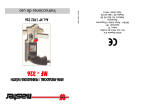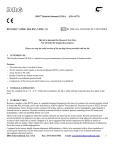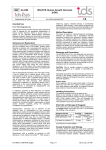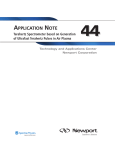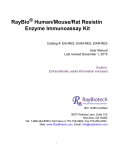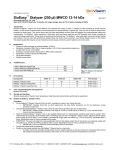Download "user manual"
Transcript
B-Bridge International, Inc. Rat Resistin ELISA Kit User Manual UM-101401 Published 01 June 2005 Catalog# K1014-1 See List of Components for Storage Conditions FOR RESEARCH USE ONLY Rat Resistin ELISA Kit User Manual Table of Contents I. II. III. IV. V. VI. VII. VIII. IX. Introduction and Protocol Overview List of Components Additional Materials Required Reagent Preparation and Storage Sample Preparation and Storage Rat Resistin ELISA Protocol Calculation of Results Troubleshooting Guide References 3 5 6 7 8 9 11 12 13 Notice to Purchaser This product is to be used for Research Purposes Only. It is not to be used for Drug or Diagnostic Purposes, nor is it intended for Human Use. B-Bridge products may not be resold, modified for resale, or used to manufacture commercial products without the express written consent of B-Bridge International, Inc. EXCEPT AS OTHERWISE EXPRESSLY SET FORTH IN THIS USER MANUAL, B-BRIDGE DOES NOT MAKE ANY REPRESENTATION OR WARRANTIES OR CONDITIONS OF ANY KIND, EITHER EXPRESSED OR IMPLIED, WITH RESPECT TO THE PRODUCTS, OR INFORMATION DISCLOSED HEREUNDER, INCLUDING, BUT NOT LIMITED TO, THE IMPLIED WARRANTIES OF MERCHANTABILITY, FIT FOR A PARTICULAR PURPOSE, OR NONINFRINGEMENT OF THE INTELLECTUAL PROPERTY RIGHTS OF THIRD PARTIES. ©2004, B-Bridge International, Inc. All Rights Reserved. B-Bridge International, Inc. 2 www.b-bridge.com Rat Resistin ELISA Kit User Manual I. Introduction and Protocol Overview Resistin, a product of the RSTN gene, is a peptide hormone belonging to the class of cysteine-rich secreted proteins which is termed the RELM family, and is also described as ADSF (Adipose Tissue-Specific Secretory Factor) and FIZZ3 (Found in Inflammatory Zone). Rat resistin contains 114 amino acids as a prepeptide, and its hydrophobic signal peptide is cleaved before secretion. Resistin circulates in rat blood as a dimeric protein consisting of two 96 amino acid polypeptides, which are disulfide-linked. Resistin may be an important link between obesity and insulin resistance. Mouse resistin, specifically produced and secreted by adipocyte, acts on skeletal muscle myocytes, hepatocytes and adipocytes to reduce their sensitivity to insulin. Steppan et al. have suggested that resistin suppresses the ability of insulin to stimulate glucose uptake. They have also suggested that resistin is present at elevated levels in the blood of obese mice, and is down regulated by fasting and antidiabetic drugs (TZDs). On the other hand, several studies demonstrated reduced resistin expression in adipose tissue of obese mice and increased levels in leptin deficient ob/ob mice and Zucker diabetic fatty rats in response to TZDs. Other studies have shown that mouse resistin increases during the differentiation of adipocytes, but it also seems to inhibit adipogenesis. Nevertheless, the human adipogenic differentiation is likely to be associated with a down regulation of resistin gene expression. The B-Bridge Rat Resistin ELISA Kit is designed to measure the concentration of rat resistin in rat serum or tissue culture medium. B-Bridge International, Inc. 3 www.b-bridge.com Rat Resistin ELISA Kit User Manual The principle of the assay is shown in Figure 1. Standards or samples are incubated in microtiter wells coated with a rabbit polyclonal anti-rat resistin antibody. The wells are washed and biotin-labelled rabbit polyclonal anti-rat resistin antibody is added and incubated with the captured resistin. After a thorough wash, streptavidin-horseradish peroxidase (HRP) conjugate is added. Following subsequent incubation and washing, the bound conjugate is allowed to react with the substrate H2O2-tetramethylbenzidine (TMB). The reaction is quenched by addition of acidic solution and absorbance of the resulting product is measured at 450 nm. The absorbance correlates to the concentration of resistin. A standard curve is constructed by plotting absorbance values versus known resistin standard concentrations and concentrations of unknown samples are determined by interpolation on this curve. Biotin-labeled rabbit polyclonal anti-rat resistin antibody Resistin Assay Principle Streptavidin-HRP Conjugate • • • • ♦♦ ♦ ♦ YY YY 1st Reaction E E 2nd Reaction Substrate H2O2-TMB E 3rd Reaction Color Development E • • • ♦♦ ♦ Y YY ♦♦ ♦ YY Y E Y YY YY Y • • • ♦♦ ♦ E YY Y YY Y E E E • • • ♦♦ ♦ Y YY Figure 1. YY Y A rabbit polyclonal anti-rat rresistin esistin antibody coated plate B-Bridge International, Inc. 4 www.b-bridge.com Rat Resistin ELISA Kit User Manual II. • List of Components Store all components at 2-8 °C. DO NOT FREEZE. 1 10X WASH SOLUTION 1 Bottle (100 ml) 2 1X SAMPLE DILUENT . PRIMARY ANTIBODY-COATED PLATE 2 Bottle (10 ml) 3 1 Plate One plate holds 12x8-well strips (96 wells), with adsorbed Rabbit Polyclonal Anti-Rat Resistin Antibody. Plate is provided in a resealable foil pouch with desiccant. 4 RAT RESISTIN MASTER STANDARD 1 Vial (lyophilized) 20 ng/ml 5 QUALITY CONTROL 2 Vial (lyophilized) High and Low 6 BIOTINYLATED SECONDARY ANTIBODY SOLUTION 1 Bottle (13 ml) Rabbit Polyclonal Anti-Rat Resistin Antibody, Biotin Labeled 7 CONJUGATE SOLUTION 1 Bottle (13 ml) Streptavidin- Horseradish Peroxidase Conjugate 8 SUBSTRATE 1 Bottle (13 ml) H2O2 Tetramethylbenzidine (TMB) 9 STOP SOLUTION 1 Bottle (13 ml) (0.2M H2SO4) PLATE SEALERS 1 Package Six sealers per package MSDS forms are available on our website—please visit www.b-bridge.com B-Bridge International, Inc. 5 www.b-bridge.com Rat Resistin ELISA Kit User Manual III. Additional Materials Required The following materials are required, but not supplied: • Graduated cylinder • Micropipettor(s) and disposable pipette tips • Null strips for 96-well plate • 96-well plate or manual strip washer • Paper towels or absorbent paper • Plate reader capable of measuring absorbance at a wavelength of 450 nm (reference filter at 620-650 nm, optional) • Orbital microplate shaker capable of approximately 300 rpm • Well-closed containers such as microtubes (1.5 ml or more in capacity) B-Bridge International, Inc. 6 www.b-bridge.com Rat Resistin ELISA Kit User Manual IV. Reagent Preparation and Storage Allow all the reagents to equilibrate at room temperature (25°C) prior to the start of the reagent preparation. 1. 1X Wash Solution Prepare 1X Wash Solution by mixing all of the 10X Wash Solution (100 ml) with 900 ml of deionized water or equivalent. After preparation, store 1X Wash Solution at 2-8°C. The diluted Wash Solution is stable for 1 month at 2-8°C. 2. Rat Resistin Master Standard Solution Prepare each Resistin Standard by diluting the supplied resistin standard solutions (20 ng/ml) with 1 ml Sample Diluent for duplicates. Do not store the diluted standard solutions. The standards are stable until the expiration date at -20°C. Table 1: Serial Dilution of Resistin Standards Master Standard Vol. 1X Diluent Concentration Master Std. 0 µl 20 ng/ml 500 µl of 20 ng/ml Master Std. 500 µl 10 ng/ml 500 µl of 10 ng/ml Std. 500 µl 5 ng/ml 500 µl of 5 ng/ml Std. 500 µl 2.5 ng/ml 500 µl of 2.5 ng/ml Std. 750 µl 1 ng/ml 500 µl of 1 ng/ml Std. 500 µl 0.5 ng/ml 500 µl of 0.5 ng/ml Std. 500 µl 0.25 ng/ml 3. Quality Controls Reconstitute the Quality Controls by adding 350 µl of sample diluent to each vial containing lyophilized Quality Controls. Reconstituted Quality Controls are now ready to use. Reconstituted Quality Controls are stable until the expiration date at -20°C. . Note: Do not mix reagents from different kits unless they have the same lot number. B-Bridge International, Inc. 7 www.b-bridge.com Rat Resistin ELISA Kit User Manual V. Sample Preparation and Storage Allow all the reagents to equilibrate at room temperature (25°C) prior to the start of the sample preparation. 1. For Assaying Samples in singlets Mix 10 µl of samples with 190 µl of 1X Sample Diluent. 2. For Assaying Samples in duplicates Mix 15 µl of samples with 285 µl of 1X Sample Diluent. Note: Serum samples should be stored frozen preferably at –80ºC. Repeated freeze-thawing should be avoided. Undiluted samples are stable at least a week at 2-8ºC or one day at room temperature (25°C). Diluted samples have to be stored frozen. B-Bridge International, Inc. 8 www.b-bridge.com Rat Resistin ELISA Kit User Manual VI. Rat Resistin ELISA Protocol Note: Allow all reagents to come to room temperature (25°C) prior to the start of the assay and prepare 1X Wash Solution, Quality Controls, Resistin Standards, and Samples as described in the previous sections. 1. Remove Primary Antibody-Coated Plate from its foil pouch. Remove any unneeded strips from the plate frame, reseal them in the foil pouch, and return the foil pouch to 2-8°C. If a 96-well plate washer is used, the plate frame should be completely filled with wells by adding as many null strips as necessary. Identify well position(s) for each sample on a data sheet or plate map. 2. Add 100 µl of diluted Standards, Quality Controls, and samples to the appropriate number of antibody-coated wells. Every plate must include the standard series to properly correlate the sample readings. 3. Cover plate(s) securely with a plate sealer and incubate at room temperature (25°C) for 60 minutes on an orbital microplate shaker at ca. 300 rpm. 4. After incubation, thoroughly wash the plate(s) 3 times with Wash Solution as follows: a. Carefully remove the plate sealer, avoiding splashing, and discard appropriately. b. Completely aspirate the liquid from the wells using a plate washer. c. Fill each well with 1X Wash Solution (~350 µl/well) and immediately aspirate. Avoid overflow. d. Repeat Step 4c two more times for a total of three washes. e. Invert the plate(s) and gently tap on a clean absorbent towel. 5. Dispense 100 µl of the Biotinylated Secondary Antibody Solution into each well. 6. Cover plate(s) securely with a new clean plate sealer and incubate at room temperature (25°C) for 60 minutes on an orbital microplate shaker at ca. 300 rpm. 7. Repeat the wash procedure described in step 4. 8. Dispense 100 µl of Streptavidin-HRP Conjugate Solution into each well. 9. Cover plate(s) securely with a plate sealer and incubate at room temperature (25°C) for 30 minutes on an orbital microplate shaker at ca. 300 rpm. 10. Repeat the wash procedure described in step 4. 11. Dispense 100 µl of Substrate Solution into each well. Avoid exposing the microtiter plate to direct sunlight. Covering the plate with aluminum foil is recommended. 12. Cover plate(s) securely with a plate sealer and incubate at room temperature (25°C) for 10 to 20 minutes on an orbital microplate shaker at ca. 300 rpm. 13. Dispense 100 µl of Stop Solution into each well. The plate should be read immediately. 14. Read the plate at 450 nm using a plate reader. If using a dual filter instrument, the recommended reference wavelength is 620-650 nm. B-Bridge International, Inc. 9 www.b-bridge.com Rat Resistin ELISA Kit User Manual Note: If the microplate reader is not capable of reading absorbance greater than the absorbance of the highest standard, the standard curve constructed using the values measured at 405 nm can be used to determine resistin concentration of off-scale samples. The readings at 405 nm should not replace the on-scale readings at 450 nm. Figure 2. Flow Chart of Assay Procedure A Rabbit polyclonal Anti-Rat Resistin Polyclonal Antibody coated plate Diluted Standards, Quality Controls, and Samples 100 μL 1st Reaction : 25℃, 60 min, 300 rpm Prepare Wash Solution Wash ×3 (350 μL × 3) Biotinylated Rabbit Polyclonal Anti-Rat Resistin Antibody Solution 100 μL 2nd Reaction : 25 ℃, 60min, 300rpm Streptavidin-HRP Conjugate Solution 100 μL 3rd Reaction : 25℃, 60 min, 300 rpm Wash ×3 (350 μL × 3) 100 μL Substrate Solution Color Development: 25℃, 10~20 min, 300 rpm Stop Solution 100 μL Read Absorbance at 450 nm B-Bridge International, Inc. 10 www.b-bridge.com Rat Resistin ELISA Kit User Manual VII. Calculation of Results 1. Subtract the mean absorbance value of the 0 ng/ml blank from each mean absorbance value of the standard series and samples tested (Net Absorbance). 2. Plot the concentrations of each standard and the calculated Net Absorbances on the X-axis and Y-axis, respectively. Fit an appropriate regression curve to the points. 3. Determine the resistin concentrations of the samples by interpolation of the regression curve. Figure 3. Typical Standard Curve Rat Resistin ELISA Standard Curve 3,00 OD [450 nm] 2,50 2,00 1,50 1,00 0,50 0,00 0,1 1 10 Concentration of Rat Resistin [ng/ml] Figure 3: Standard Curve for rat resistin is plotted using the four-parameter function as a proportion of rat resistin concentration and absorbance at 450 nm. B-Bridge International, Inc. 11 www.b-bridge.com Rat Resistin ELISA Kit User Manual VIII. Troubleshooting Guide 1. Lack of signal or weak signal in all wells Possible explanations: • • • • 2. High signal and background in all wells Possible explanations: • • • 3. Improper or inadequate washing; be certain that all wash volumes and repetitions were correct. Improper dilution of detection antibody. Overdeveloping; decrease the incubation time before the Stop Solution is added. High background in sample wells only Possible explanations: • • 4. Omission of a reagent or a step. Improper preparation or storage of a reagent. Assay performed before reagents were allowed to come to 25°C. Plate reader did not perform well. Sample concentration was too high. Improper dilution of detection antibody. Weak signal in sample wells only Possible explanations: • • Sample concentration was too low. Improper dilution of detection antibody. B-Bridge International, Inc. 12 www.b-bridge.com Rat Resistin ELISA Kit User Manual IX. References Banerjee R.R., Lazar M.A.: Dimerization of resistin and resistin–like molecules is determined by a single cysteine. The Journal of Biological Chemistry. 276, 25970-25973, (2001) Gong H., Ni Y., Guo X., Fei L., Pan X., Guo M., Chen R.: Resistin promotes 3T3-L1 preadipocyte differentiation. Eur J Endocrinol. 150(6):885-92, (2004) Juan CC. at al.: Suppressed Gene Expression of Adipocyte Resistin in an Insulin-resistant Rat Model Probably by Elevated Free Fatty Acids. Biochemical and Biophysical Research Communications. 289, 1328-1333, (2001) Kim K.H. et al.: A Cysteine-rich Adipose Tissue-specific Secretory Factors Inhibits Adipocyte Differentiation. The Journal of Biological Chemistry. 276 (14), 11252-11256, (2001) Milan G., Granzotto M., Scarda A., Calcagno A., Pagano C., Federspil G., Vettor R.: Resistin and adiponectin expression in visceral fat of obese rats: effect of weight loss. Obes Res. 10(11):1095-103, (2002) Nogueiras R., Gallego R., Gualillo O., Caminos J.E., Garcia-Caballero T., Casanueva F.F., Dieguez C.: Resistin is expressed in different rat tissues and is regulated in a tissue- and gender-specific manner. FEBS Lett. 31;548(1-3):21-7, (2003) Pravenec M, Kazdová L, Landa V, Zídek V, Mlejnek P, Jansa P, Wang J, Qi N, Kurtz TW: Transgenic and recombinant resistin impair skeletal muscle glucose metabolism in the spontaneously hypertensive rat. J Biol Chem. 278, 45209-45215, (2003) Rajala M.W., Obici S., Scherer P.E., Rossetti L.: Adipose-derived resistin and gut-derived resistin-like molecule-beta selectively impair insulin action on glucose production. J Clin Invest. 111(2):225-30, (2003) Satoh H., Nguyen M.T., Miles P.D., Imamura T., Usui I., Olefsky J.M.: Adenovirus-mediated chronic "hyper-resistinemia" leads to in vivo insulin resistance in normal rats. J Clin Invest. 114(2):224-31, (2004) Steppan C.M., Lazar M.A.: The current biology of resistin. Journal of Internal Medicine. 255, 439-447, (2004) Steppan C.M., Lazar M.A.: Resistin and obesity-associated insulin resistance. TRENDS in Endocrinology and Metabolism. 13 (1), 18-23, (2002) Steppan C.M. at al.: A Family of Tissue-specific Resistin-like Molecules. Proc. Natl. Acad. Sci. USA. 98 (2), 502-506, (2001) Steppan C.M. et al.: The Hormone Links Obesity to Diabetes. Nature. 409, 307-312, (2001) Way J.M. et al.: Adipose Tissue Resistin Expression Is Severely Suppressed in Obesity and Stimulated by Peroxisome Proliferator-activated Receptor γ Agonists. The Journal of Biological Chemistry. 276 (28), 25651-25653, (2001) B-Bridge International, Inc. 13 www.b-bridge.com














